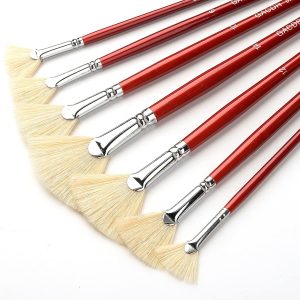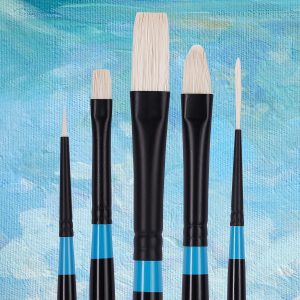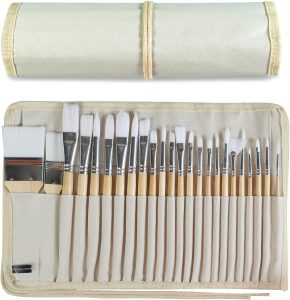Oil painting has been a revered artistic medium for centuries. Its ability to capture light, color, and texture with depth and richness is unmatched. However, to achieve the best results in oil painting, it’s not just about the paints and canvases you use; it’s also about the brushes. The right oil painting brush can make a significant difference in the outcome of your masterpiece, and finding the perfect brush can be a bit daunting with so many options on the market. Will help you navigate the world of oil painting brushes, providing recommendations and expert insights into the best options available for different needs.
Why Choosing the Right Oil Painting Brush Matters
When it comes to oil painting, the brushes you use will directly influence the texture, stroke, and detail of your work. Different brush types and bristle materials are suited for various techniques. A poor-quality brush can lead to frustrating results and hinder your ability to express your creativity. Investing in the right oil painting brushes can make the process more enjoyable and help you achieve the desired effect in your artwork.
Types of Brushes Used in Oil Painting
Before diving into the specific brands and models of brushes, it’s essential to understand the different types of brushes commonly used in oil painting. Oil painting brushes typically come in three main categories: flat, round, and filbert. Each shape is suited for different techniques and effects.
- Flat Brushes
- Flat brushes have a rectangular, flat tip. These brushes are ideal for creating broad strokes, sharp lines, and filling in large areas of color.
- Best For: Bold strokes, straight lines, covering large areas.
- Round Brushes
- Round brushes are tapered to a point, making them perfect for finer details and controlled lines.
- Best For: Detailing, intricate lines, and controlled application of paint.
- Filbert Brushes
- Filbert brushes are a hybrid between round and flat brushes. They have a rounded edge that allows for softer, more fluid strokes.
- Best For: Soft edges, blending, and creating a variety of textures.
- Fan Brushes
- Fan brushes have bristles arranged in a fan shape, perfect for creating texture and blending colors.
- Best For: Textural effects, foliage, blending, and soft highlights.
- Bright Brushes
- Bright brushes have a shorter bristle length than flat brushes. They are typically used for short, controlled strokes and more precise work.
- Best For: Short, controlled strokes, details, and textured work.
Bristle Materials for Oil Painting Brushes

The bristles of oil painting brushes can be made from a variety of materials. The two most common bristle types are natural hair and synthetic fibers, and each has its pros and cons.
- Natural Hair Bristles
- Natural bristles are made from animal hair, such as hog, sable, or mongoose. These brushes hold paint more effectively, and the bristles tend to spread and create texture naturally, which is ideal for oil paints.
- Best For: Traditional artists who appreciate the feel of natural bristles and the paint-handling capacity they offer.
- Synthetic Bristles
- Synthetic brushes are made from man-made fibers like nylon or Taklon. These brushes are generally more affordable, durable, and easier to clean than natural hair brushes. They’re also great for people with allergies to animal hair.
- Best For: Beginners, artists on a budget, or those who prefer synthetic materials over animal-derived ones.
Top Brands for Oil Painting Brushes

When it comes to choosing the best oil painting brushes, there are several well-known and respected brands that stand out for their craftsmanship, quality, and reliability. Below are some of the best oil painting brush brands that have earned their place in the art world:
- Winsor & Newton
- Winsor & Newton is one of the most trusted brands in the world of oil painting. Their brushes are crafted from high-quality materials, and the brand offers a wide range of options, including both synthetic and natural hair brushes. They are known for their durability and ability to hold paint well.
- Recommended Brushes: Winsor & Newton Series 7 Kolinsky Sable Brushes, Winsor & Newton Winton Oil Brushes.
- Princeton
- Princeton is another renowned brand that creates professional-grade brushes at an affordable price point. They offer an impressive selection of brushes with both synthetic and natural bristles.
- Recommended Brushes: Princeton Velvetouch Oil Painting Brushes, Princeton Catalyst Polytip Brushes.
- Da Vinci
- Da Vinci is an excellent choice for artists who appreciate precision and quality. Their brushes are hand-crafted, using both natural and synthetic materials, ensuring a wide selection of brushes for different styles and techniques.
- Recommended Brushes: Da Vinci CosmoTop Spin Brushes, Da Vinci Series 10 Kolinsky Sable Brushes.
- Escoda
- Escoda is a Spanish brand that’s highly regarded for its excellent craftsmanship and high-performance brushes. They are known for offering a broad range of brushes made from top-tier natural and synthetic bristles.
- Recommended Brushes: Escoda Versatil Brushes, Escoda Prado Brushes.
- Robert Simmons
- Robert Simmons offers some of the finest oil painting brushes for both professional and beginner artists. Their brushes are known for their strength, flexibility, and ability to retain their shape after extensive use.
- Recommended Brushes: Robert Simmons Signet Brushes, Robert Simmons Monarch Brushes.
Best Oil Painting Brushes for Specific Needs

Now that we have an overview of the different types of brushes and brands, let’s delve into some of the best oil painting brushes for specific needs.
- Best Overall Oil Painting Brush Set
- Winsor & Newton Winton Oil Brush Set: This set includes brushes made from durable synthetic filaments, ideal for oil painting. It provides a versatile range of sizes and shapes, making it an excellent choice for artists of all skill levels.
- Best Oil Painting Brushes for Beginners
- Princeton Velvetouch Oil Painting Brushes: With their ergonomic handles and high-quality synthetic bristles, these brushes offer an excellent starting point for beginners. They mimic the feel of natural hair while being easy to clean and maintain.
- Best Professional Oil Painting Brushes
- Da Vinci Kolinsky Sable Brushes: Known for their exceptional quality and precision, these Kolinsky sable brushes are perfect for professional artists who demand the highest quality tools. The fine hair holds paint effortlessly and creates sharp, controlled lines.
- Best Brushes for Fine Detail Work
- Escoda Versatil Round Brushes: These brushes are ideal for delicate work, offering fine points for intricate detailing and controlled brushstrokes. They are made with synthetic fibers that mimic the qualities of sable hair.
- Best Brushes for Textural Effects
- Princeton Catalyst Polytip Brushes: These brushes are made with synthetic filaments that are perfect for creating texture in your oil paintings. The tips are shaped to hold more paint, making them ideal for techniques like impasto and thick, textured strokes.
How to Maintain Your Oil Painting Brushes
Proper care and maintenance of your oil painting brushes are essential to ensure they last for years and continue to perform at their best. Here are some tips for keeping your brushes in top shape:
- Clean Brushes Immediately After Use: Oil paint can harden on your brushes if left untreated, so always clean your brushes after each session. Use a solvent like mineral spirits or turpentine to remove the paint from the bristles. Follow up with warm, soapy water to remove any residual paint or solvents.
- Reshape the Bristles: After cleaning, reshape the brush by gently pressing it with your fingers. This helps maintain the brush’s original form and prevents the bristles from splaying out.
- Store Brushes Properly: Never store your brushes with the bristles facing down, as this can damage the tips. Store them flat or with the brush heads facing up. Using a brush holder or a dedicated brush box is a great way to keep your brushes organized and protected.
- Avoid Letting Brushes Sit in Solvents: While solvents like turpentine are necessary for cleaning, avoid soaking your brushes in them for long periods. This can cause the bristles to deteriorate.
Frequently Asked Questions
1. What are the best brushes for beginners in oil painting?
Answer: For beginners, synthetic brushes like the Princeton Velvetouch Oil Painting Brushes are an excellent choice. They offer a good balance between performance and affordability, and they are easier to clean and maintain.
2. Should I buy natural or synthetic brushes for oil painting?
Answer: Both types have their benefits. Natural brushes, like Kolinsky sable, are more traditional and hold more paint, offering superior control. However, synthetic brushes like those from Princeton or Escoda are more durable, cost-effective, and easier to clean.
3. Can I use the same brushes for oil and acrylic painting?
Answer: While it’s possible to use the same brushes for both oil and acrylic painting, it’s generally recommended to have separate brushes. Acrylics can be more abrasive and may damage brushes designed for oil paints.
4. How often should I clean my oil painting brushes?
Answer: Clean your brushes after each painting session. The faster you clean them, the longer they will last, as dried paint can permanently damage the bristles.
5. What’s the difference between a filbert and a flat brush?
Answer: Filbert brushes have rounded tips, making them more versatile and suitable for blending and softer edges. Flat brushes have straight, square tips and are best for creating sharp, clean lines or covering large areas.
6. Can I use oil painting brushes for watercolor painting?
Answer: While it’s possible to use oil brushes for watercolor painting, it’s not ideal. Oil brushes tend to be stiffer, which could make it difficult to achieve the delicate effects associated with watercolor.
7. What size oil painting brushes should I use?
Answer: The size of your brush will depend on the scale of your painting. For small details, use smaller brushes (e.g., size 0–4). For larger areas or background work, use larger brushes (e.g., size 6–12 or even larger).
Conclusion
finding the best oil painting brushes is about understanding your painting style and selecting brushes that suit your needs. From fine detail work to bold strokes, there is a brush for every technique. Invest in high-quality brushes, maintain them properly, and your oil painting experience will be that much more enjoyable and rewarding.


Leave a Reply